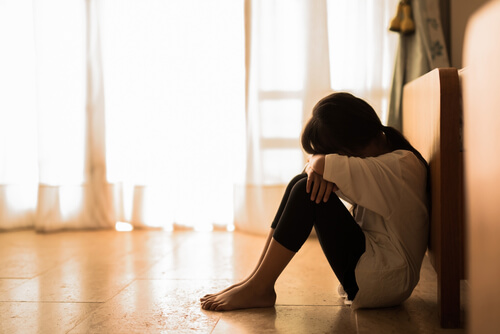Hikikomori, Japanese Youth Isolated in their Rooms

The Hikikomori are young Japanese people who shun the idea of leaving their room. In Japanese culture solitude has always been a traditional value. It represents searching for wisdom about oneself, nature and social relations. In some ways, it is feudal, but also positive. But in the current Japanese society, this constructive solitude has become pathological isolation.

Following the Second World War, Japanese society began to rapidly develop economically, which lead to increasingly demanding school and work environments. Young people received a strict education. It promoted the iron discipline of knowledge acquisition over everything else. And it set aside the communicative and psychological issues of the students in the classrooms.
Hikikomori families see their children as a shameful, as something to hide from their neighbors and relatives for fear of a scandal and being stigmatized.
Faced with this pressure from their families and society, Japanese youth have developed a form of isolation that is rare in the Western world. They spend months or years in their rooms without intending to return to the real world.
The definition of Hikikomori
The first person who coined the term Hikikomori was the Japanese psychiatrist Tamaki Saito, in his book “Hikikomori, Rescue Manual” in 2002. He describes Japanese youth who retreat into their rooms as victims of an increasingly suffocating and competitive educational system and labor market. He points out that the main problem is the poor communication that exists between parents and children of some Japanese families.
Current Japanese society
Japanese society has developed with a dizzying speed. But an economic crisis began in which if you want to move up socially, you must demonstrate an impeccable ability and discipline. Many couples who have experienced this economic growth have had only one child. In that child, they have deposited all their hopes of a future of a better life. They have also projected onto their child some frustrated desires of own their youth.

Families make a huge economic effort so that children can succeed in the workplace. They send them to the best schools that have lots of homework. They give them many extracurricular activities that leaves little or no space for leisure and relationships with their peers.
Schools in Japan
The schools in Japan have a very demanding and varied educational level and curriculum. They have continuous exams, homework and the teacher strictly supervises the student’s activity. Often, Japanese youth do intensive after-school sessions that involve spending evenings and weekends at school.
Also, sometimes intensive camps are organized in schools where schoolchildren sleep and eat in classrooms, and continuously take exams on various subjects until they pass. Many do not sleep if they have not passed all the tests.
“Never consider study as an obligation, but as the opportunity to penetrate the beautiful and wonderful world of knowledge”.
Many never adapt, either because they have special educational needs or because such stress causes various psychological disorders. Unfortunately, Japan doesn’t have enough support systems to help youth that cannot handle this pace.
Relationships with peers – competition, isolation and harassment
Many of these children and adolescents start to look their peers with suspicion and distrust. Many are bullied because of poor grades or other parts of their personal lives. There is no counselor or social worker to look after their mental needs in schools, so the problem continues.

They don’t see work as a way to use their skills and gain personal independence. They see it as a hostile terrain that they fear because they might not be able to live up to expectations of productivity.
Many see themselves as alone, stressed, isolated, pressured by their family and with a future job that is too competitive for their abilities. If we add the incredible technological expansion in the country, it is an explosive cocktail. Many will feel more attracted by isolation and by creating “a virtual life”. It is a way of saying enough to society and their families.
What happens to Hikikomori
The families of the Hikikomori see their children as shameful. They are something to hide from their neighbors and relatives for fear of a scandal and being stigmatized. They think it may be a temporary problem.
However, if a young person locks themselves in their room for weeks and there is no clear answer for the parents, the problem tends to become chronic. Young people drop out of school and lock themselves in their rooms in total isolation. They eat, sleep and use virtual entertainment within those 4 walls.
The world seems better through a computer, watching movies, reading, playing video games, listening to music and sleeping. They have a very limited self-care regimen and if they have, for example, to cut their hair, they do it themselves. They pass years like this. It has become an epidemic in Japan because there are around two million Hikikomori in the country.
Japanese youth are victims of an increasingly suffocating and competitive educational system and labor market.
How to solve the problem
The Japanese authorities have already launched an intervention plan. This is a great generational loss. They are investigating ways to help these young people. Many psychologists point out that the best intervention would be a systemic-family. They need to ensure that the family progressively communicates with the patient and can get them out of their confinement.
Integration into society must be gradual. On many occasions, recovered Hikikomori are those who guide and support other youth to leave their voluntary confinement. The problem is not a social phobia, agoraphobia or extreme shyness. It is different.
The solution should be preventative. Japanese society must take this problem seriously to lower the level of demand and social isolation promoted by schools.
The Hikikomori are young Japanese people who shun the idea of leaving their room. In Japanese culture solitude has always been a traditional value. It represents searching for wisdom about oneself, nature and social relations. In some ways, it is feudal, but also positive. But in the current Japanese society, this constructive solitude has become pathological isolation.

Following the Second World War, Japanese society began to rapidly develop economically, which lead to increasingly demanding school and work environments. Young people received a strict education. It promoted the iron discipline of knowledge acquisition over everything else. And it set aside the communicative and psychological issues of the students in the classrooms.
Hikikomori families see their children as a shameful, as something to hide from their neighbors and relatives for fear of a scandal and being stigmatized.
Faced with this pressure from their families and society, Japanese youth have developed a form of isolation that is rare in the Western world. They spend months or years in their rooms without intending to return to the real world.
The definition of Hikikomori
The first person who coined the term Hikikomori was the Japanese psychiatrist Tamaki Saito, in his book “Hikikomori, Rescue Manual” in 2002. He describes Japanese youth who retreat into their rooms as victims of an increasingly suffocating and competitive educational system and labor market. He points out that the main problem is the poor communication that exists between parents and children of some Japanese families.
Current Japanese society
Japanese society has developed with a dizzying speed. But an economic crisis began in which if you want to move up socially, you must demonstrate an impeccable ability and discipline. Many couples who have experienced this economic growth have had only one child. In that child, they have deposited all their hopes of a future of a better life. They have also projected onto their child some frustrated desires of own their youth.

Families make a huge economic effort so that children can succeed in the workplace. They send them to the best schools that have lots of homework. They give them many extracurricular activities that leaves little or no space for leisure and relationships with their peers.
Schools in Japan
The schools in Japan have a very demanding and varied educational level and curriculum. They have continuous exams, homework and the teacher strictly supervises the student’s activity. Often, Japanese youth do intensive after-school sessions that involve spending evenings and weekends at school.
Also, sometimes intensive camps are organized in schools where schoolchildren sleep and eat in classrooms, and continuously take exams on various subjects until they pass. Many do not sleep if they have not passed all the tests.
“Never consider study as an obligation, but as the opportunity to penetrate the beautiful and wonderful world of knowledge”.
Many never adapt, either because they have special educational needs or because such stress causes various psychological disorders. Unfortunately, Japan doesn’t have enough support systems to help youth that cannot handle this pace.
Relationships with peers – competition, isolation and harassment
Many of these children and adolescents start to look their peers with suspicion and distrust. Many are bullied because of poor grades or other parts of their personal lives. There is no counselor or social worker to look after their mental needs in schools, so the problem continues.

They don’t see work as a way to use their skills and gain personal independence. They see it as a hostile terrain that they fear because they might not be able to live up to expectations of productivity.
Many see themselves as alone, stressed, isolated, pressured by their family and with a future job that is too competitive for their abilities. If we add the incredible technological expansion in the country, it is an explosive cocktail. Many will feel more attracted by isolation and by creating “a virtual life”. It is a way of saying enough to society and their families.
What happens to Hikikomori
The families of the Hikikomori see their children as shameful. They are something to hide from their neighbors and relatives for fear of a scandal and being stigmatized. They think it may be a temporary problem.
However, if a young person locks themselves in their room for weeks and there is no clear answer for the parents, the problem tends to become chronic. Young people drop out of school and lock themselves in their rooms in total isolation. They eat, sleep and use virtual entertainment within those 4 walls.
The world seems better through a computer, watching movies, reading, playing video games, listening to music and sleeping. They have a very limited self-care regimen and if they have, for example, to cut their hair, they do it themselves. They pass years like this. It has become an epidemic in Japan because there are around two million Hikikomori in the country.
Japanese youth are victims of an increasingly suffocating and competitive educational system and labor market.
How to solve the problem
The Japanese authorities have already launched an intervention plan. This is a great generational loss. They are investigating ways to help these young people. Many psychologists point out that the best intervention would be a systemic-family. They need to ensure that the family progressively communicates with the patient and can get them out of their confinement.
Integration into society must be gradual. On many occasions, recovered Hikikomori are those who guide and support other youth to leave their voluntary confinement. The problem is not a social phobia, agoraphobia or extreme shyness. It is different.
The solution should be preventative. Japanese society must take this problem seriously to lower the level of demand and social isolation promoted by schools.
This text is provided for informational purposes only and does not replace consultation with a professional. If in doubt, consult your specialist.







